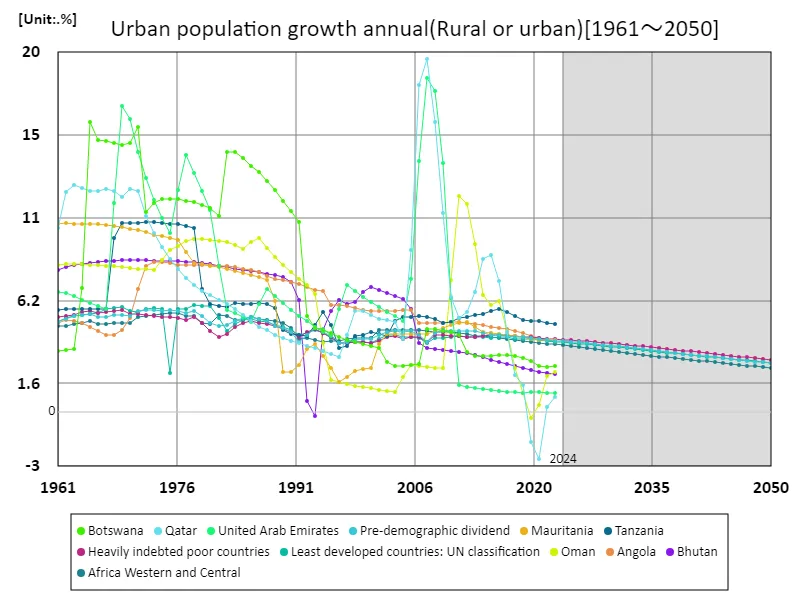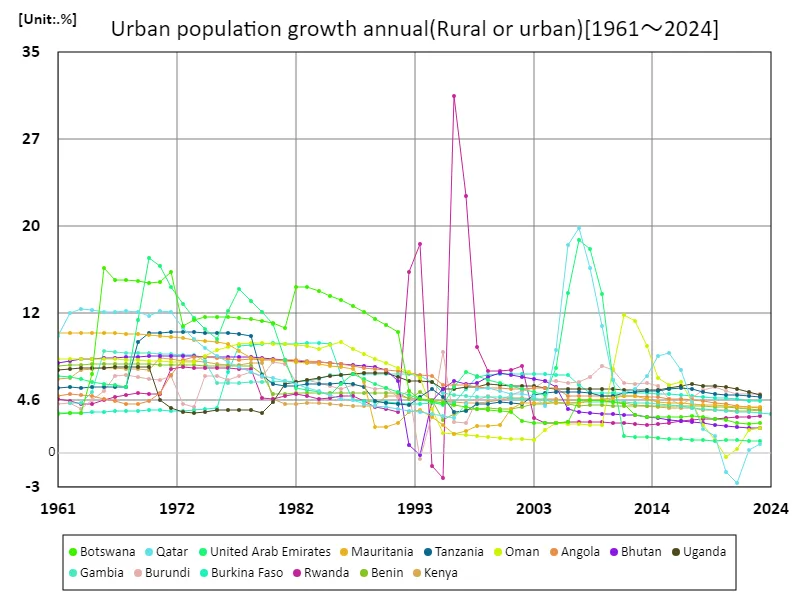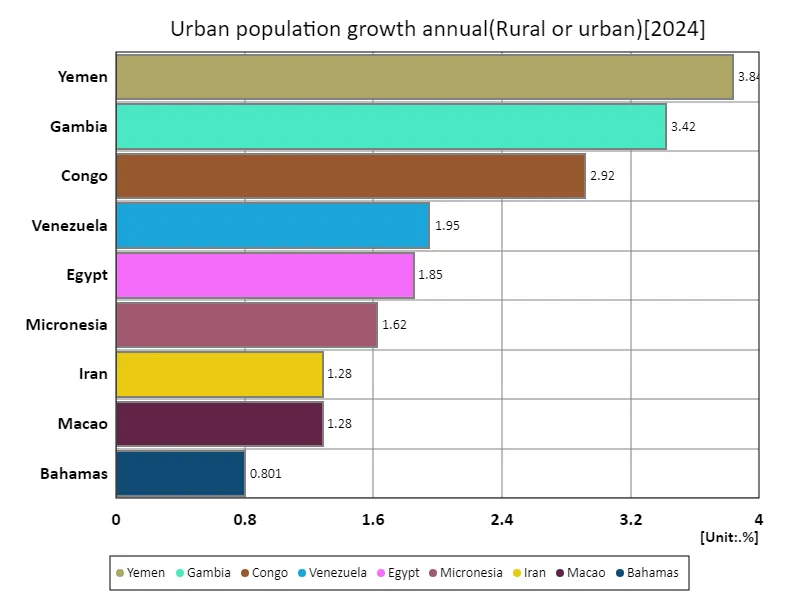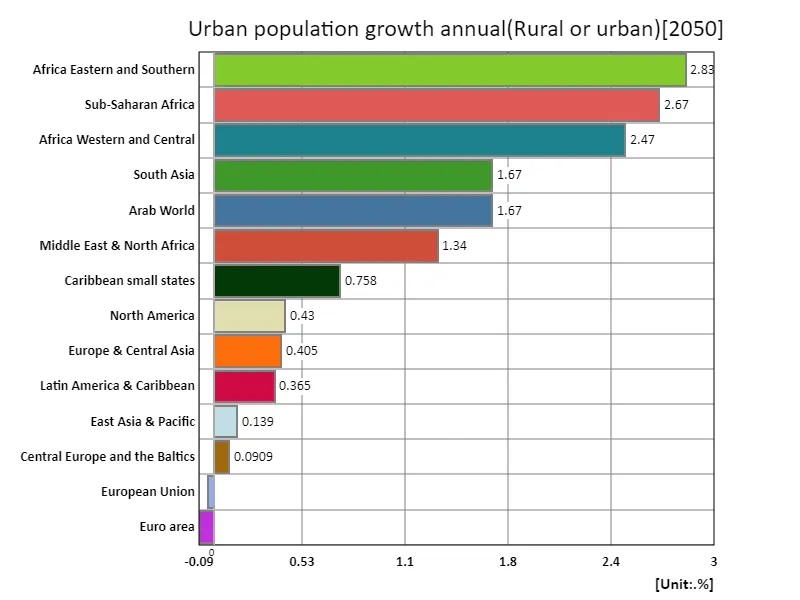Abstract
Recent data suggests that annual urban population growth in 2050 will reach up to 2.91% in highly indebted countries. This suggests that historically, countries with greater economic burdens are becoming more urbanized. Generally, economically challenged countries experience continued rural-urban migration and more pronounced urban population growth. The background to this phenomenon is the expected increase in employment opportunities and improvement in living standards in urban areas. However, increasing urbanization can also put strain on urban infrastructure and increase social problems, so these countries need to address urban issues alongside economic pressures. Therefore, it can be said that indebted countries with high urban population growth rates are being forced to reconsider their economic policies and urban planning.
Annual increase in urban population
Looking at data from 1961 to 2050, we see notable fluctuations in annual urban population growth. Qatar in particular saw its urban population annual growth rate reach 19.6% in 2007, before declining sharply to 4.19%. This is a result of Qatar experiencing rapid economic growth and urbanization. The high growth rate in the early 2000s reflected rapid economic development driven by abundant oil resources and the resulting concentration in cities. On the other hand, as an overall trend, there has been a notable increase in urban population since the 1970s as urbanization progressed in developing and emerging countries. In these countries, rural-urban migration continued and urban population growth accelerated. Recently, while many developed countries have entered a period of maturity and their growth rates have been declining, developing countries have continued to show high growth rates. As such, the annual increase in urban population is closely related to the economic development of a country or region, and in countries that have experienced rapid growth, the rate of growth tends to decline after peaking. We can see that the progress of urbanization and the associated social and economic challenges are influencing changes in urban population.


The maximum is 19.6%[2007] of Qatar, and the current value is about 4.19%
Annual urban population growth around the world
Considering data from 1961 to 2024, there is a noticeable fluctuation in the annual increase in urban population. In particular, Rwanda recorded a high growth rate of 31.1% in 1996, but this figure has now fallen to 10.4%. This significant decline marks Rwanda’s transition from rapid urbanization to a period of stability, driven by a maturing economy and evolving urban planning. Rwanda’s peak urban population growth can be attributed to accelerated urban migration following civil war and political turmoil. Post-war reconstruction, international aid, and economic reconstruction all encouraged people to move to cities, but in recent years the rate of increase has slowed down as cities’ infrastructure improves and economic growth matures. In general, the annual growth rate of urban population is high in developing countries, and migration to urban areas tends to increase with economic growth and industrialization. On the other hand, in developed and semi-developed countries, urbanization has slowed and the rate of growth has stabilized or declined in many cases. The case of Rwanda is a typical example of a transition from rapid urbanization to a period of stability, illustrating how a country’s economic and social structure changes affect urban demographics.


The maximum is 31.1%[1996] of Rwanda, and the current value is about 10.4%
Annual urban population growth for countries around the world (latest year)
According to 2024 data, Yemen will have the highest annual urban population growth at 3.84%, compared to an overall average of 1.91% and a total of 19.1%. The data shows the differences in urbanization rates and economic development across countries. Yemen’s high urban population growth rate reflects ongoing rural-to-urban migration. Despite economic challenges and political instability, Yemen is experiencing high rates of urban migration. Accelerating urbanization is driven by people seeking greater concentration of employment opportunities and improved living conditions. With an overall average growth rate of 1.91%, many countries are urbanizing, but only a few are experiencing rates as high as Yemen. In developed countries, urbanization has entered a mature stage and the rate of growth has remained relatively low and stable. Meanwhile, developing countries continue to see high rates of population growth, characterized by ongoing migration to urban areas. The total urban population growth rate of 19.1% indicates that urbanization is increasing overall, but there is wide variation in growth rates across countries. The progress of urbanization is closely linked to each country’s economic situation and social change. While there is a need to develop urban infrastructure and improve living standards, at the same time, issues such as overcrowding and resource management are also emerging.


The maximum is 3.84% of Yemen, the average is 2.11%, and the total is 19%
Annual urban population growth (region, latest year)
Data for 2050 show that the highest annual urban population growth will be in Eastern and Southern Africa, reaching 2.83%, with an overall average of 1.05% and a total of 14.7%. The data shows the progress of urbanization by region and how it varies. The high growth rates in eastern and southern Africa reflect ongoing rapid urbanization. In these regions, migration from rural to urban areas is on the rise as the economy grows and develops. Rapid population growth is driven by people seeking economic opportunities and improved living conditions, but urban infrastructure and services have not kept up, exposing the city to challenges such as overcrowding and inadequate infrastructure. Although urbanization is progressing worldwide, with the overall average growth rate being 1.05%, there are variations in growth rates between regions. While urbanization in developed countries has reached maturity and the rate of urbanization is declining, developing and emerging countries continue to experience high rates of urbanization. The trends show differences according to the stage of economic development and the progress of urbanization. The total urban population growth rate of 14.7% shows that while urbanization is progressing globally, different challenges need to be addressed in different regions.


The maximum is 2.83% of Africa Eastern and Southern, the average is 1.05%, and the total is 14.7%



Comments